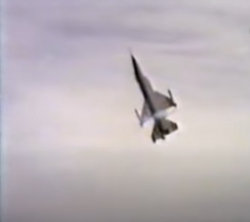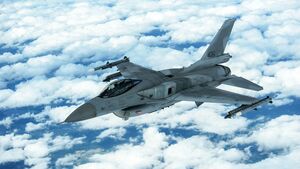JAS-16 Raven: Difference between revisions
No edit summary |
No edit summary |
||
| (5 intermediate revisions by the same user not shown) | |||
| Line 10: | Line 10: | ||
|designer = | |designer = | ||
|builder = | |builder = | ||
|first flight = 13 | |first flight = 13 July 1972 | ||
|introduction = | |introduction = | ||
|introduced = | |introduced = 5 January 1976 | ||
|retired = | |retired = | ||
|status = In active service | |status = In active service | ||
|primary user = {{flagicon|Acrea}} [[Acrean Air Force|Royal Acrean Air Force]] <br> {{flagicon|Shalum}} [[Imperial Shalumite Air Force]] <br> {{flagicon|Ruvelka}} [[Ruvelkan Imperial Air Force]] | |primary user = {{flagicon|Acrea}} [[Acrean Air Force|Royal Acrean Air Force]] <br> {{flagicon|Shalum}} [[Imperial Shalumite Air Force]] <br> {{flagicon|Ruvelka}} [[Ruvelkan Imperial Air Force]] <br> {{flagicon|Ravka}} Ravkan Air Force | ||
|more users = | |more users = | ||
|produced = 1971-Present | |produced = 1971-Present | ||
| Line 31: | Line 31: | ||
==Development== | ==Development== | ||
Development of | Development of what would become the JAS-16 began in earnest in 1967, with a set of requirements being laid out for a new light, single-engine, single-seat tactical fighter. | ||
The original MDA prototype first tested in 1969 was a purebred short-range, supreme dogfighting aircraft. Lacking a long-range radar, its armament consisted only of six infrared missiles. Although performance of the aircraft was considered exceptional, its capabilities left something to be desired. Subsequent prototypes were fitted with a longer-ranged X-band pulse-doppler radar , with the airframe slightly enlarged and strengthened to accommodate this. With testing completed in 1977, the new prototypes were considered satisfactory. The first examples were delivered to squadrons in 1978. | The original MDA prototype first tested in 1969 was a purebred short-range, supreme dogfighting aircraft. Lacking a long-range radar, its armament consisted only of six infrared missiles. Although performance of the aircraft was considered exceptional, its capabilities left something to be desired. Subsequent prototypes were fitted with a longer-ranged X-band pulse-doppler radar , with the airframe slightly enlarged and strengthened to accommodate this. With testing completed in 1977, the new prototypes were considered satisfactory. The first examples were delivered to squadrons in 1978. | ||
| Line 66: | Line 66: | ||
* {{flagicon|Acrea}} [[Acrean Air Force|Royal Acrean Air Force]] | * {{flagicon|Acrea}} [[Acrean Air Force|Royal Acrean Air Force]] | ||
* {{flagicon|Ruvelka}} [[Ruvelkan Imperial Air Force]] | * {{flagicon|Ruvelka}} [[Ruvelkan Imperial Air Force]] | ||
* {{flagicon|Shalum}} [[Imperial Shalumite Air Force]] | |||
* {{flagicon|Ravka}} Ravkan Air Force | |||
==Specifications (JAS-16E)== | ==Specifications (JAS-16E)== | ||
Latest revision as of 16:15, 19 July 2023
| JAS-16 Raven | |
|---|---|

| |
| An Acrean Air Force JAS-16C in 2011 | |
| Role | Air superiority fighter |
| National origin | |
| Manufacturer | MDA SE |
| Design group | MDA |
| First flight | 13 July 1972 |
| Introduction | 5 January 1976 |
| Status | In active service |
| Primary user | |
| Produced | 1971-Present |
The MDA JAS-16 Raven is a single-seat, single-engined 4th generation multirole fighter designed by MDA SE for the Royal Acrean Air Force. First conceived as a lightweight air defence fighter, the Raven became a highly versatile aircraft capable of performing a wide range of combat roles. It is well known not only for its versatility, but its low procurement and operating costs. Although a relatively simple design, the Raven was introduced with a multitude of unique and advanced features for the period, such as a relaxed stability design, fly-by-wire controls, and a side-mounted pressure sensitive control stick.
The Raven is one of the most prolific Acrean combat aircraft ever built, with over 3,500 examples produced since it was introduced into service in 1976.
Development
Development of what would become the JAS-16 began in earnest in 1967, with a set of requirements being laid out for a new light, single-engine, single-seat tactical fighter.
The original MDA prototype first tested in 1969 was a purebred short-range, supreme dogfighting aircraft. Lacking a long-range radar, its armament consisted only of six infrared missiles. Although performance of the aircraft was considered exceptional, its capabilities left something to be desired. Subsequent prototypes were fitted with a longer-ranged X-band pulse-doppler radar , with the airframe slightly enlarged and strengthened to accommodate this. With testing completed in 1977, the new prototypes were considered satisfactory. The first examples were delivered to squadrons in 1978.
Design
Overview
The JAS-16 Raven is a single engine, highly maneuverable, multirole tactical fighter. Although originally envisioned as a light tactical fighter with a primary focus of air defence, it rapidly evolved into a capable multirole platform. It was designed to be cost effective and easy to maintain. Following its design philosophy, the aircraft is lightweight and nimble, and uses its size and weight in combination a powerful engine and advanced flight control systems to achieve exceptional kinematic performance. Since its introduction, the JAS-16 has been iterated on repeatedly to update it with ever more capable systems. Although upgradability was not a conscious design goal, by its simple-to-maintain and accessible nature the Raven's design has proven to be very receptive to even major systems overhauls.
Flight Characteristics
The JAS-16 was one of the first production aircraft in Tyran with an intended relaxed stability design. As a consequence of of its negative stability, the JAS-16 used advanced fly-by-wire flight control systems to counter the aircraft's tendency to depart from controlled flight. The JAS-16 relies solely on its fly-by-wire, with no hydraulic or mechanical linkages between the pilot's controls and the aircraft's control surfaces. The flight control systems incorporate limiters to prevent unwanted flight behaviours such as slip, adverse yaw, or high angles-of-attack which cause the aircraft to lose directional stability and controllability. Early variants of the JAS-16A demonstrated a loss of stability at higher angles of attack, and were at risk of departing flight. Consequently the flight control systems limited the pilot to prevent such an occurence. The JAS-16A was limited to 25 degrees AOA. Consequently, the JAS-16 had an larger minimum turn radius compared to contemporary high-alpha capable aircraft such as the EF-168 Viper which could retain good controllability at up to 40 degrees of alpha, however possessed an excellent turn rate of up to 28 degrees per second at corner airspeed. It also possesses excellent energy maneuvering characteristics, able to both maintain airspeed well and regain lost airspeed exceptionally quickly.
The JAS-16's flight characteristics changed dramatically with the introduction of the JAS-16C in 1983. The Block II incorporated massive changes to the airframe and powerplant. It fitted a newer, higher-thrust engine equipped with a multi-axis thrust vectoring system- a nozzle with actuated divergent flaps to provide thrust vectoring. The introduction of MATV required a total overhaul of the flight control systems. Altogether, these changes radically altered the flight characteristics of the Raven in the slow-speed and high-alpha regime, with test pilots describing Ravens equipped with MATV as feeling like a completely different plane. The aircraft's slow speed performance was drastically improved, with thrust vectoring enabling much greater nose authority at airspeeds where the Raven proved to be poorly responsive previously. During flight testing, a MATV-equipped JAS-16C managed to sustain flight at nearly 90 degrees AOA. Subsequent variants of the Raven following the initial C-series have retained and improved upon these systems.
Avionics
Operational History
Refusal War
Zemplen War
Midsummer War
Variants
- JAS-16A/B: The JAS-16A (single seat) and JAS-16B (two-seat) were the original production aircraft introduced into service in 1974.
- JAS-16C/D: The JAS-16C (single seat) and JAS-16D (two seat) variant which entered service in 1983 introduced an improved radar, improved digital flight control systems, and better avionics. The C model also introduced the capability to use an improved IRST, though it was rarely fitted to production aircraft. An additional two hardpoints were included on the sides of the air intake, primarily intended for use with targeting pods. The aircraft was fitted with the EJ-900-84 engine. Later production blocks introduced aerodynamic improvements as well as the EF-900-89 engine which was the first to introduce thrust vectoring with the multi-axis MATV system.
- JAS-16E/F: Nicknamed the "Kingraven" by aircrew, the JAS-16E/F model is usually considered the ultimate fighter variant of the JAS-16. First introduced in 1994, the most significant changes to the JAS-16E/F was a new EJ-915 engine and a new AESA radar, a technology previously used only on the JA26 Draken. Additional systems improvements of the E/F included new onboard EW systems, new navigation systems, and improvements to the cockpit displays with higher resolution screens and replacement the majority of older instrument displays with an additional two MFD screens along the center pedestal of the cockpit.
Operators
Current Operators
Specifications (JAS-16E)
General Characteristics
- Crew: 1
- Length: 15.06 m
- Wingspan: 9.96 m
- Height: 4.9 m
- Wing Area: 28 m²
- Empty Weight: 8,600 kg (18,960 lbs)
- Fuel Capacity: 4,560 kg (10,053 lbs)
- Powerplant: 1 × MDA EJ-915 afterburning turbofan, 90 kN (20,233 lbf) dry thrust, 145 kN (32,500 lbf) reheat
Performance
- Maximum Speed: Mach 2.1 at high altitude
- Mach 1.2 at sea level
- Mach 1.5 supercruise at altitude
- Service Ceiling: In excess of 19,000 m



